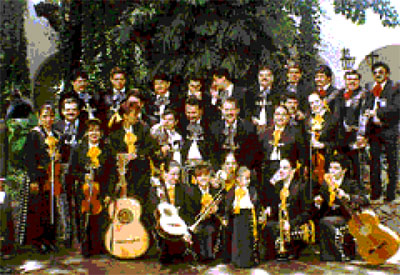Mexonline.com

|
|
|
|
The Mariachi - What Does It Mean?
|
|
Story & photo by Jorge Tamayo
Musicologists and folklorists have argued for years over the origin of the word - Mariachi.
The explanation that appears most frequently - especially on record jackets and in travel brochures - is that it is a variation of the French word mariage, meaning wedding or marriage, and comes from the time in the nineteenth century when Maximillian, a Frenchman, was Emperor of Mexico.
According to this myth the Mariachi was named by the French after the celebration with which it was most commonly associated. But this explanation, always regarded as highly doubtful by linguists, was totally discredited recently when a use of the word was found that predated the time when the French arrived in Mexico.
Currently, however, the best scholarly opinion is that the word mariachi has native roots. One theory is that it comes from the name of the wood used to make the platform on which the performers danced to the music of the village musicians. But whatever its true source - and the truth may never be discovered with absolute certainty - the word today has one meaning that is crystal clear: Mariachi means on of the most exciting and enchanting musical ensembles found anywhere in the world.
The Beginning of the Mariachi We Know Today
Although the origins of Mariachi music go back hundreds of years, in the form we know it the Mariachi began in the nineteenth century in the Mexican state of Jalisco - according to popular legend, in the town of Cocula. The Mariachi was the distinctive version of the Spanish theatrical orchestra of violins, harp and guitars which developed in and around Jalisco. In other areas such as Veracruz and the Huasteca region in the northeast, the ensemble evolved differently. By the end of the nineteenth century, in Cocula the vihuela, two violins, and the guitarr� n (which had replaced the harp) were the instruments of the Mariachi.

The principal music played by these early Mariachis was the SON, the popular music of the day. A mixture of folk traditions from Spain, Mexico, and Africa, the son was found in many regions of the country. The son from Jalisco is called the son jalisciense. La Negra is the best-known example.
Sones from other regions include the son jarocho or veracruzano, from the region around the Gulf port of Veracruz; and the son huasteco, from northeastern Mexico. The most famous example of the son jarocho is La Bamba . A typical son huasteco, also known as the huapango, is La Malague� a. It is interesting to note that there are some sones, such as El Gusto, which are common in all three regions and clearly date back to a common ancestor.
Editor's Note: Jorge Tamayo (tamayoj@imac-ac.edu.mx) operates the IMAC Instituto Mexico Americano de Cultura,
A Spanish Language School in Guadalajara, Mexico (http://www.mexonline.com/imac.htm).
Do you have a unique story about Mexico, it's history, culture or your own travels that our readers might enjoy here on Mexonline.com? If so we'd be happy to read it and consider it for inclusion into our Feature Stories section. Just take a look at our writer's guidelines for more information and how to send us your story. Let's hear from you!
|
|